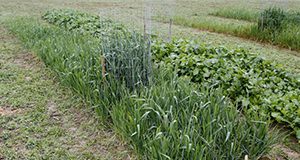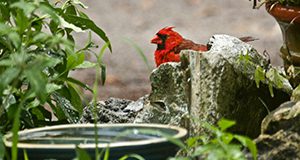A variety of forest birds will use trees and shrubs in built areas as breeding, wintering, and stopover habitat. Scientists have created an online tool to help these birds and the people who appreciate them. This 20-page fact sheet written by Mark Hostetler and Jan-Michael Archer and published by the UF/IFAS Department of Wildlife Ecology and Conservation describes the online tool and shows how it can help forest birds.
edis.ifas.ufl.edu/uw418
Tag: Landscaping for Wildlife
Temporary Food Plot Deterrents for Deer: Do They Work?

Many Floridians enjoy the opportunity to hunt, watch, or photograph white-tailed deer. Hunters and landowners often plant cool season forage plots both to attract wildlife and to provide a dependable food source. But where there is a high deer population or scarce food resources, deer may forage on food plots as soon as the plants emerge and before they become established. This fact sheet presents the results of research conducted at the UF/IFAS North Florida Research and Education Center in Quincy into the effectiveness of various strategies hunters and landowners can use to temporarily limit access to new food plots until the plants are well established and strong enough to attract and sustain hungry deer through the winter. Written by Holly Ober, Cheryl Mackowiak, and Ann Blount and published by the UF/IFAS Department of Wildlife Ecology and Conservation.
http://edis.ifas.ufl.edu/uw410
Native Plants That Benefit Native Wildlife in the Florida Panhandle
 The key to enhancing wildlife (and attracting it to your property) is to provide the resources wildlife need. This means supplying food, water, and cover within the space you own and manage. Because the needs of each wildlife species for food and cover vary from one season to the next, a mix of plant species is required to meet the needs of a species all year round. And because each species has different needs, attracting and maintaining a wide variety of wildlife year round requires a wide diversity of plants. A property owner interested in attracting wildlife should nurture a wide variety of native plants to ensure that there is a large assortment of food and cover options available all the time. This 8-page fact sheet was written by Holly K. Ober and Gary W. Knox, and published by the UF Department of Wildlife Ecology and Conservation, October 2013.
The key to enhancing wildlife (and attracting it to your property) is to provide the resources wildlife need. This means supplying food, water, and cover within the space you own and manage. Because the needs of each wildlife species for food and cover vary from one season to the next, a mix of plant species is required to meet the needs of a species all year round. And because each species has different needs, attracting and maintaining a wide variety of wildlife year round requires a wide diversity of plants. A property owner interested in attracting wildlife should nurture a wide variety of native plants to ensure that there is a large assortment of food and cover options available all the time. This 8-page fact sheet was written by Holly K. Ober and Gary W. Knox, and published by the UF Department of Wildlife Ecology and Conservation, October 2013.
http://edis.ifas.ufl.edu/uw384
Attracting Backyard Birds: Bird Feeder Selection (WEC162/UW192)
Today, more than 50 million Americans put out a billion pounds of bird food each year. Bird feeders can be used to supplement the food provided by native plantings. They also provide a way to observe birds at close range. This 8-page fact sheet suggests useful guidelines for selecting feeders, food, feeder location, cleaning feeders, and managing for cats and squirrels. Written by Emma V. Willcox, Mark E. Hostetler, Martin B. Main, and Maena Voigt, and published by the UF Department of Wildlife Ecology and Conservation, April 2011.
http://edis.ifas.ufl.edu/uw192
